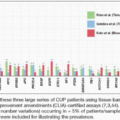Introduction of High-Throughput Sequencing
Timothy Philip DiPeri
Funda Meric-Bernstam
Introduction
At the turn of the millennium, one of the largest breakthroughs in contemporary medical science was announced—the majority of the human genome had been sequenced, unveiling a new road map for human biology (1). Over the past two decades, sequencing technologies have advanced at a rapid pace, which has had broad implications for the detection and treatment of human disease (2). The field of oncology has been at the forefront of these developments, considering the relevance of genetics in cancer. High-throughput sequencing, or next-generation sequencing (NGS), has made comprehensive molecular profiling of cancers feasible and has profoundly changed our understanding of human tumor biology (3).
Although NGS was once considered cost-prohibitive and utilized sparingly for research efforts, it is now commonplace in oncology practices (4). This has given rise to the era of precision oncology, which refers to a personalized approach to cancer medicine by using an individual tumor’s molecular characteristics to guide therapeutic decision-making (5). Rapid identification of alterations in cancer-related genes, which may have diagnostic, prognostic, and/or therapeutic relevance, has revolutionized modern cancer care. In this chapter, we will introduce high-throughput sequencing by reviewing the historical context into the sequencing of the cancer genome, discussing platforms to detect alterations within the genome and transcriptome, how high-throughput sequencing data can be leveraged for the treatment of cancer patients, and challenges with integrating these data into clinical practice.
Sequencing the Cancer Genome
Shortly after completion of the Human Genome Project, several international efforts were launched to comprehensively profile a diverse set of cancers and to gain insight into tumorigenesis, most notably The Cancer Genome Atlas (TCGA) and International Cancer Genome Consortium (ICGC) (6,7). Although many oncogenic drivers/tumor suppressors had previously been identified, it was clear that an understanding of the spectrum of genomic aberrations that drive cancers was imperative. The vision for the TCGA project, as put forth by the National Institutes of Health (NIH), was ambitious—multiple centers and a vast array of multiomics approaches were utilized to molecularly profile >30 different tumor types (8). Methods to acquire these data included RNA sequencing
(RNASeq), micro RNA sequencing (miRNASeq), DNA sequencing (DNASeq), single-nucleotide polymorphism (SNP)-based platforms, and array-based DNA methylation sequencing for nucleic acid sequencing, as well as reverse-phase protein array (RPPA) for proteomic assessment (6). Subsequently, the TCGA Pan-Cancer project was implemented and sought to further analyze the molecular profiles of individual tumors, as well as compare genetic aberrations between tumor types (8). Similarly, the ICGC characterized >50 cancer types, with the goal of discovering highly prevalent mutations, standardizing reporting methods on an international scale, providing granular data at the single-nucleotide level, and to make this data publicly accessible (7).
(RNASeq), micro RNA sequencing (miRNASeq), DNA sequencing (DNASeq), single-nucleotide polymorphism (SNP)-based platforms, and array-based DNA methylation sequencing for nucleic acid sequencing, as well as reverse-phase protein array (RPPA) for proteomic assessment (6). Subsequently, the TCGA Pan-Cancer project was implemented and sought to further analyze the molecular profiles of individual tumors, as well as compare genetic aberrations between tumor types (8). Similarly, the ICGC characterized >50 cancer types, with the goal of discovering highly prevalent mutations, standardizing reporting methods on an international scale, providing granular data at the single-nucleotide level, and to make this data publicly accessible (7).
Progress in the field of cancer biology that has stemmed from these efforts cannot be overstated. The field of oncology was previously predominated by a tumor-centric approach to treatment, but it is now evident that tumors with vastly different origins can have overlapping molecular drivers, and often tumors of the same origin are molecularly distinct (8). Publicly available data from the TCGA and ICGC have allowed researchers around the globe to make progress in identifying biomarkers, discovering new targets for therapy, and providing an opportunity to develop bioinformatics tools to better understand the available data, which will ultimately improve the care of cancer patients (6).
Detection of Genomic Alterations
High-throughput DNASeq can be performed using several molecular biology techniques, including cyclic reversible termination, pyrosequencing, synthesis by ligation, and real-time sequencing (9). Sequences determined by these assays are then mapped onto the human reference genome using bioinformatics tools, which enables the calling of single-nucleotide variants, insertions/deletions, fusions, and copy number variations (Figure 9.1). These NGS technologies are advantageous over first-generation Sanger sequencing, considering that the volume of data that can be produced with one run can exceed 1 billion short reads (9). Tissue input for these assays includes solid tumor tissue, individual tumor cells, and plasma (liquid biopsy). Although fresh frozen tissue provides adequate tissue for performing NGS, samples are often formalin fixed and paraffin embedded (FFPE), which can lead to the degradation of both DNA and RNA (10). Despite these limitations, most modern NGS platforms can utilize FFPE tissue for sequencing analysis.
Stay updated, free articles. Join our Telegram channel

Full access? Get Clinical Tree




